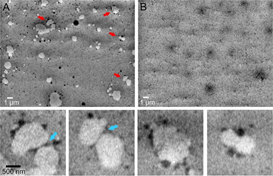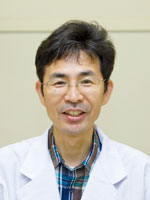Point
We developed a novel dielectric microscope capable of observing living cells and other biological samples in solutions at a high resolution of approximately 10 nm.
 |
| Developed scanning electron-assisted dielectric microscope (SE-ADM) |

Observation of cells and nanobeads using novel dielectric microscope
(Okada & Ogura, Sci. Rep. 2017,7:43025)
|
|

Visualization of milk fat emulsion
(Ogura & Okada, BBRC, 2017,491, pp.1021)
|
Background
Recently, there has been a need to observe living cells and nanoparticles in solutions in an unstained, non-immobilized, undamaged condition. Observation of living biological samples used to be exceptionally difficult, as observation using electron microscopy and other techniques requires a vacuum condition and pretreatment such as staining and fixation.
Outcomes and Methods
The developed microscope is based on the novel principle of visualizing the difference in the dielectric constant between water and the target object. It enables observation of untreated (i.e., in an unstained, unfixed, undamaged condition) biological samples and organic nanomaterials in solutions. Moreover, we have achieved a high resolution of 10 nm. In FY2017, we succeeded in making a detailed observation of the internal structure of cells in their natural state, which had been difficult with conventional technology, by improving the sample preparation technique and image analysis technology. We have also successfully observed biological samples, organic nanoparticles, ceramic particles, etc. in solutions as well as milk, all in their natural state.
Future Plan
In continuing joint research with a measurement instrument manufacturer, we have made progress in equipment development for commercial application. We have also conducted technical consulting related to this technology and signed contracts with five companies: one material chemicals company, one analysis company, two food companies, and one fats and oils company. Additionally, we have conducted funded joint research using this technology with a major beverage company and a commodity chemicals company. In the future, this technology will be adaptable to research and development in a very wide range of fields, including nanoparticle materials related to pharmaceuticals, foods, cosmetics, materials/chemicals, precision equipment, machinery, and petrochemistry.
Contact
 |
|
Toshihiko Ogura
Chief Senior Researcher
Structure Physiology Research Group, Biomedical Research Institute
1-1-1 Higashi, Tsukuba, Ibaraki 305-8566 Japan
E-mail: t-ogura*aist.go.jp (Please convert “*” to “@”)
|